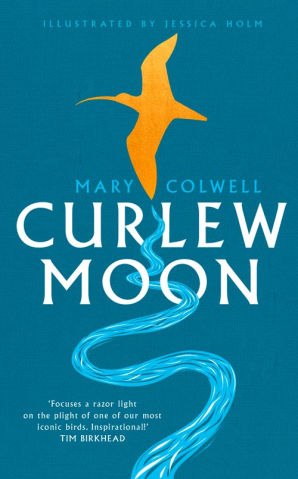
Yesterday was World Curlew Day. Everybody likes Curlews these days. GWCT and Curlew Country want your money to save the Curlew, BTO want your money to save the Curlew and RSPB is spending over a million pounds over five years on Curlews but isn’t gagging for your money it seems! Wow!
The author of Curlew Moon, Mary Colwell, is partly responsible for stirring up the interest in this declining bird and her book will help maintain a focus on it into the future. Colwell walked from the west of Ireland to the east of England on a Curlew pilgrimage, seeing places where this wading bird hangs on and where its place in folklore and legend are secure, if not its continued existence into the future.
I enjoyed the book and particularly the first half of it. Colwell sets the scene well and introduces the bird to us with evident affection. And the stories of myth and legend in Ireland are wonderful. But as the journey of discovery and exploration nears its end the reader might expect some resolution of the issues, a call to action or a plan for a better future, and this book is rather reticent about those. That’s fair enough because this bird’s problems are severe and may be largely insoluble. The author has set up forums and discussions where stakeholders can try to find ways forward and I’d guess that these will certainly slow the loss of Curlew through increasing action on the ground in some places. They are very much to be welcomed.
Curlews are emblematic of the problems faced by much wildlife in the UK – they have declined for decades and decades and the main cause of that decline has been the loss of suitable habitat for nesting – agricultural land which is managed at low intensity is now pretty much restricted to the uplands and a few nature reserves and that’s where Curlew tend to hang on. Because they are long-lived birds they probably do hang on in many places for years after the local population becomes functionally extinct as the adults may long outlive the ability of their territories to produce any young to contribute to the next generation. That may be where we are in Northamptonshire which, I was slightly surprised to see in the latest county bird report, has a few pairs of Curlew still, but I’m glad to see that they do produce some young.
Of course, grouse moors get a friendly mention as they have higher densities of Curlew than similar moorland not managed for grouse shooting: and I was pleased that Colwell correctly states that the nesting densities of Curlew are twice as high on managed grouse moors than they are on other moors (not the 6+ times as high that I am often told they are by those supporting grouse shooting). And, very importantly (and again as stated by the author), the nesting success of Curlew on grouse moors is about three times as high as it is on non-grouse moors – that’s probably even more important. But I didn’t feel that this chapter, Curlews and Controversy, properly got to grips with the real controversy which is what is the future of a system of management that benefits a few species (of which the Curlew has become the most quoted) but disadvantages so many others with an entirely artificial habitat that depends for its income stream on wildlife crime and which increases carbon emissions, increases flood risk and increases water treatment costs. If the world were run by Curlews then they might well vote for more grouse moors, but they wouldn’t be doing other species, including our own, any favours by doing so.
We are all Curlew fans, but I’m not a Curlew-optimist. This book, which I certainly recommend that you read, is strong on the attractions of the bird and clear on the problems it faces. And when you look at the problems, the message is strong that almost everything we do has disadvantaged this species, whether it be peat extraction, overgrazing, afforestation, switching from hay to silage, loss of rough pasture, failure to control shooting abroad and loss of estuarine habitat used in winter. All these issues need tackling, and are being tackled, but not with resounding success – that’s hardly surprising when the juggernaut of unsustainable development bears down on wildlife at all corners and in so many ways. But to the extent that thinking of Curlews can help the wider battle then the motivation provided by this book must be a good thing.
The illustrations, line drawings by Jessica Holm, are welcome but some are given so little space on the page that their detail cannot shine through to its full extent. The ‘Notes’ at the end are a rather sketchy reference section to lead the interested reader to the science underlying this subject but I found them more useful to get into the literature surrounding the Curlew.
Curlew Moon by Mary Colwell is published by William Collins.
Remarkable Birds by Mark Avery is published by Thames and Hudson – for reviews see here.
Inglorious: conflict in the uplands by Mark Avery is published by Bloomsbury – for reviews see here.
[registration_form]
A few points. Shooting interests like to make much of higher levels of Curlews and some other birds on managed grouse moors, relative to non-managed moors.
However, as I keep pointing out, these comparisons are highly misleading. Even shooting interests admit that there is huge variability in the productivity of moorland as regards the amount of Red Grouse raised. Some moors producing much more, and other moorland failing to produce many Red Grouse even after quite a lot of time and money spent managing them for grouse.
In other word, all moorland is not equal. Grouse shooting is the sort of very wealthy people, and the best grouse moors tend to be owned by the very wealthiest people. In other words, over the last 150 years there has been a selection process, where the wealthiest landowners have acquired the naturally most productive moorland. I think we can safely say that moorland which naturally produces high numbers of grouse, produces high numbers of other moorland birds.
Moorland which is less productive, and which naturally produced low or lower numbers of Red Grouse, was either never adopted for grouse shooting, or was abandoned as grouse moor. In other words all moorland is not equal when it comes to how many birds including Red Grouse it produces. Given the money and land acquisition focus of grouse moor owners, it is unlikely much high quality moor was never purchased and adopted for use as grouse moor.
Therefore when shooting interests claim that their management methods prove that these management methods are good for avian biodiversity, because they have higher levels of other breeding birds, compared to non-managed moors, they are being disingenuous, and actually dishonest. It is well known in grouse shooting circles that all moors are not equal. Indeed if you look at one of the estate agents who specialise in selling moorland for grouse shooting etc, a lot of emphasis is put on the productivity of the moorland.
What I am saying is that the most heavily managed grouse moors have been cherry picked, because naturally they were the most productive moorland. Which makes comparing them to moorland, which was not purchased and adopted as grouse moor, precisely because of it’s low productivity, quite deliberately misleading.
It’s interesting also to note that the latest BTO feature on Curlew conservation, makes note that strip burning by shooting interests might be bad for Curlews.
I wish the RSPB, Wildlife Trusts, WWT, Woodland Trust, Vincent Wildlife Trust etc, etc, etc would do one hell of a lot more to point out that the intensive agriculture we have in this country that is knocking hell out of our wildlife across the board could be dramatically reduced by the exceedingly simple expedient of cutting down food wastage. I’ve just googled one of the latest reports and it estimates we waste approx six million tonnes of food in the UK each year that could and should have been consumed. That’s a financial value of 17 billions pounds worth of wasted food. Even the four million tonnes of unavoidable food waste could, I imagine, have been fed to pigs so even if you continue to eat meat the source of it would have been far, far less ecologically damaging than that say from highly subsidized sheep farming – we are cursed with intensive AND extensive agriculture in this country. I’d rather see subsidies going from upland sheep farming to tackling our food waste (and/or the NHS) wouldn’t that be a considerably better use of resources for conservation and achieving genuine food security than the nonsensical situation right now? It would also take pressure of habitats abroad such as the South American rain forest that are being denuded to supply food to wasteful and overweight consumers here when there are still too many citizens in those countries going hungry. There was a rather significant step forward recently when the govt anti food waste campaign finally got round to mentioning preventing ‘deforestation’ as a reason to cut food waste. Sadly even that’s progress, but incredibly anemic compared to the info that should be part of the campaign. Add in the grain and soymeal that’s used in raising and supplementing the diets of tens of millions of gamebirds raised and released for shooting – most of which will not be consumed by humans – then the scope for reducing the impacts of intensive agriculture through avoiding waste and ludicrous hobbies are enormous. Of course I don’t suppose the NFU and some of its members are bothered that farming is making money from sending food to landfill rather than feeding people, money’s money after all, but it would be great if the conservation/environmental sector really tackled this issue and fought for far better promotion of the issues involved. This is not even (before?) looking at the issue of eating less animal protein, just cutting food waste. There really has to be more joined up thinking from the relevant orgs here, every time they mention how wildlife is struggling because of intensive agriculture they should simultaneously mention our disgusting levels of food waste surely? The same points are also pretty relevant for over consuming and wasting paper, timber, plastic, metal, textiles….
I think the point of how managed grouse moors give some protection to wild bird populations is being missed. It is because predators are controlled. I recently watched foxes stalking in a new wetland area. What is the use of a new area for wading birds without control? In the past farmers would have culled foxes, badgers, gulls, corvids and hawks. They all eat the eggs and fledgling birds of waders. The farmers and their workers kept chickens so culling was essential which also protected wild birds. Now either the law, or public opinion is against them. We need to control the predators. Young foxes look sweet but they kill thousands of birds and hedgehogs.